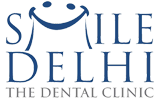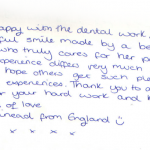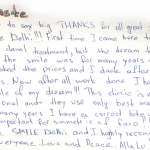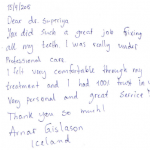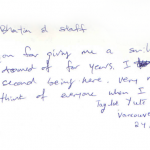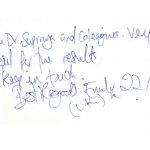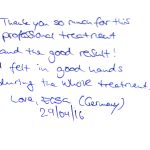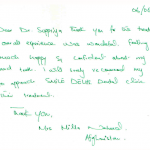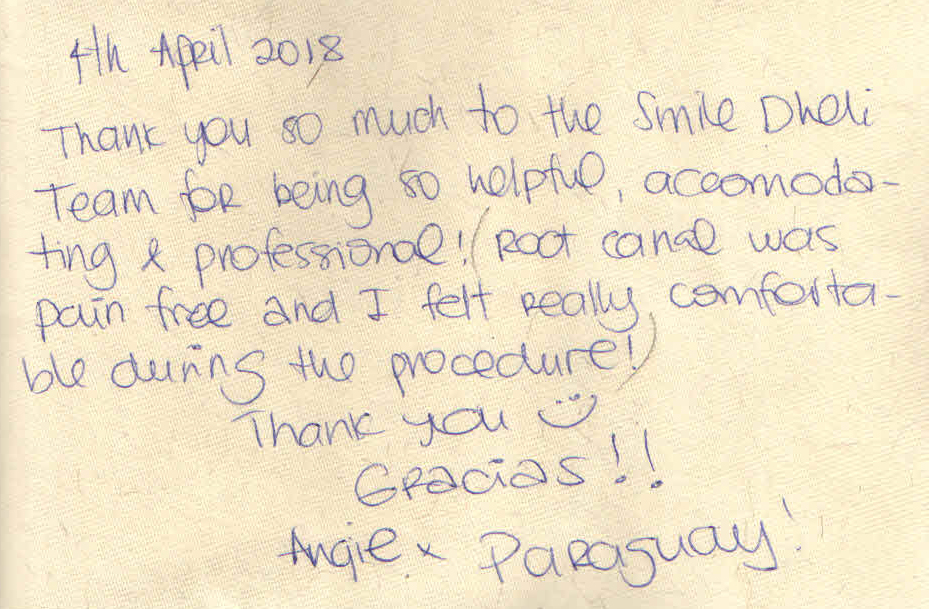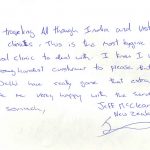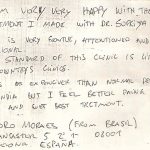Treatment of Gum Disease
The goals of gum disease treatment are to identify and eliminate the factors that are making the person more susceptible to gum disease. Also to control the risk of infection, promote reattachment of healthy gums to teeth, reduce swelling and the depth of pockets and to stop disease progression.
There are a variety of treatments for gum disease depending on the stage and extent of the gum disease, how you may have responded to earlier treatments, and your overall health. It is also adviced to quit smoking and changing certain behaviors as a way to improve treatment outcome.
Treatments in dental clinics in Delhi, range from non-surgical therapies that control bacterial growth to surgical procedures to restore supportive tissues.
Most factors can be eliminated by establishing more consistent and thorough oral hygiene habits and professional dental cleanings. Thus dentists in Delhi and dentists in India are motivating patients through a regularized ‘reminder system’ to get their dental cleaning’s done every six months.
If there are certain risk factors such as smoking or uncontrolled diabetes that are contributing to the gum disease, they need to be addressed or eliminated. Infact in many cases the dentists in Delhi, through regular dental check-ups and cleaning of teeth have helped patients become aware of certain systemic diseases like diabetes,etc.
Treatments for gum disease that don’t involve surgery include (Non-surgical Treatments):
Cleaning Teeth
There are several techniques that can be used to deep clean your teeth without surgery. They all remove plaque and tarter to prevent gum irritation.
Gum disease also cause bad breath. Bad breath is most frequently associated with a condition of the mouth like gum disease. As the bacteria that are normally present in the mouth break down plaque and tartar, they release chemicals that have a strong odour. Bad breath can also come from plaque that builds up on the tongue. As the plaque and tartar are removed from the teeth and tongue with regular brushing, flossing, and professional dental cleaning’s, it can be eliminated. This is the easiest way to reverse bad breath, but it can take a while for the mouth odour to completely disappear. A person needs to be consistent and persistent with oral hygiene to reverse the condition.
i) Oral hygiene
Mild cases of gum disease can usually be treated by maintaining a good level of oral hygiene. You must practice proper oral hygiene to treat and control gum disease. You should also cut back on any smoking and control your diabetes. Good oral hygiene involves:
- Brushing your teeth for about two minutes twice a day with fluoride (a natural mineral that helps protect against tooth decay) toothpaste.
- Flossing your teeth regularly – preferably daily, before brushing your teeth
- Not smoking
- Routinely visiting your dentist for a check-up and professional cleaning, at least twice every year, but more frequently if necessary
ii) Mouthwash
Dentist may recommend using an antimicrobial mouth-rinse containing chlorhexidine or hexetidine to disinfect the mouth if it helps to reduce and control the build-up of plaque (the sticky substance that forms when bacteria collects on the surface of your teeth). Dentists in Delhi, will be able to advise you about which type of mouthwash is most suitable and how to use it.
Chlorhexidine mouthwash can stain your teeth brown if you use it regularly. Rinse your mouth thoroughly between brushing your teeth and using a chlorhexidine mouthwash because some ingredients in toothpaste can prevent the mouthwash working.
iii) Antiseptic chip and antibiotic gel & microspheres
The medication is available as pellets or as a gelatin-filled antiseptic chip can help keep enzymes from causing tooth damage. This can be placed in deep gum pockets (space between gum and tooth) after deep scaling and root planing to kill stubborn bacteria and reduce the size of gum pockets.
Other antibiotics, including doxycycline, tetracycline, and minocycline may also be used to treat gum disease, as determined by your dentist.
These modes of delivering antibiotic therapy are very effective because the antibiotic is released slowly over the course of about seven days.
Additional treatment such as xylocaine and NSAIDs may be needed for pain control in chronic gingivitis and ANUG.
Now dental clinics in Delhi, are using precise medicines as per the requirement of the patient which help in providing quick relief to the symptoms.
iv) Enzyme suppressant
A low dose of the medication doxycycline that keeps destructive enzymes in check. They help to hold back the body’s enzyme response. If not controlled, certain enzymes can break down gum tissue. This medication is in tablet form. It is used in combination with scaling and root planing.
v) Medications
A number of medications can be used to treat gingivitis.
Medications may be used with treatment that includes scaling and root planning, but they cannot always take the place of surgery. Depending on how far the disease has progressed, the dentist may still suggest surgical treatment.
Painkillers
Paracetamol and ibuprofen are the most commonly prescribed painkillers. They may help reduce pain and discomfort.
Antibiotics
Antibiotic treatments can be used either in combination with surgery and other therapies, or alone, to treat acute or locally persistent areas of gum inflammation by reducing or temporarily eliminating the bacteria associated with gum disease or suppress the destruction of the tooth’s attachment to the bone and especially in treating ANUG.
Treatment with antibiotics, such as metronidazole or amoxicillin, may be recommended if you have ANUG.
vi) Scaling and polishing
Dentist may suggest that you have your teeth professionally cleaned to remove plaque and tartar (hardened plaque) that can build up on your teeth, through a deep-cleaning method called scaling and root planing. Scaling means scraping away the plaque and tartar from above and below the gum line using special instruments, then polish your teeth to remove marks or stains. If a lot of plaque or tartar has built up, you may need to have more than one scale and polish.
vii) Root planning
In some cases of gum disease, root planing (debridement) may be required. Root planing gets rid of rough spots on the tooth root where the germs or bacteria gather, and helps remove bacteria that contribute to the disease. Before having the treatment, you may need to have a local anaesthetic (painkilling medication) to numb the area. You may experience some pain and discomfort for up to 48 hours after having root planing.
In some cases a laser therapy may be used to remove plaque and tartar to help increase gum health. The gum pocket is treated with a soft tissue laser to eliminate the harmful bacteria deep in the pockets, remove unhealthy tissue and help stimulate healing. This procedure can result in less bleeding, swelling and discomfort compared to traditional deep cleaning methods.
Dentists in Delhi and dentists in India are using the most appropriate method to treat gum diseases.
Surgical Treatments
Non-surgical periodontal treatment does have its limitations. When it does not achieve gum health, surgery may be indicated to restore its health. In most of the reputed dental clinics in Delhi, surgical gum treatments are routinely done, by dental surgeons specializing in gum treatments. They are called periodontists.
In some cases, the non-surgical procedure including scaling and root planing is all that is needed to treat gum diseases.
Surgery is needed in severe gum disease when the tissue around the teeth is unhealthy and cannot be repaired with nonsurgical options. In some cases, it is necessary to remove the affected tooth. Dentists in Delhi take time out to counsel the patients and explain the procedure to them in detail.
Surgical procedures include-
i) Flap surgery/pocket reduction surgery
Surgery might be necessary if inflammation and deep pockets remain following treatment with deep cleaning and medications to gain access to all the tooth surfaces for a thorough cleaning. During this procedure the gums are lifted back and the tarter (the disease-causing bacteria) is removed. Eliminating existing bacteria and regenerating bone and tissue helps to reduce pocket depth and repair damage caused by the progression of periodontal disease. In some cases, irregular surfaces of the damaged bone are smoothed to limit areas where disease-causing bacteria can hide. The gums are then sutured back in place so that the tissue fits snugly around the tooth again so there are not the deep pockets that existed before. This method reduces the size of the space between the gum and tooth, thereby decreasing the areas where harmful bacteria can grow and decreasing the chance of serious health problems associated with gum disease. After surgery the gums will heal and fit more tightly around the tooth. Periodontists in Delhi are adept at this procedure and carry it out with patience and thoroughly.
In addition to flap surgery, your dentist may suggest procedures to help regenerate any bone or gum tissue lost to periodontists where teeth and the jaw are too damaged to heal. Membranes (filters), bone grafts or tissue-stimulating proteins can be used to encourage your body’s natural ability to regenerate bone and tissue.
ii) Bone grafts
- Bone grafting, involves using fragments of your own natural or synthetic bone or donated bone is placed in the area of bone loss, to replace bone destroyed by gum disease by helping to promote regrowth of bone which restores the stability to teeth. This is being routinely done, in reputed dental clinics in Delhi and dental clinics in India.
- A technique that can be used with bone grafting is called Guided tissue regeneration. It is performed when the bone supporting your teeth has been destroyed. This procedure stimulates bone and gum tissue growth. In this procedure, a small piece of mesh-like fabric is inserted between the bone and gum tissue. This keeps the gum tissue from growing into the area where the bone should be, allowing the bone and connective tissue to regrow to better support your teeth. Periodontists in the best dental clinics in Delhi , are doing this procedure very proficiently.
- Growth factors – proteins that can help your body naturally regrow bone may also be used.
In cases where gum tissue has been lost, your dentist may suggest a soft tissue graft.
iii) Soft tissue grafts
Soft-tissue grafts are used to cover up root surfaces that have been exposed by receding gums to protect them from decay. This procedure reinforces thin gums or fills in places where gums have receded to prevent additional recession and bone loss. In this synthetic material or tissue taken from another area of your mouth particularly roof of your mouth is used to cover exposed tooth roots, is stitched in place, adding tissue to the affected area. This can help eliminate sensitive teeth and protect the root surfaces that are softer and more difficult to clean and can improve aesthetics of your smile.
iv) Bone surgery
Smoothes shallow craters in the bone due to moderate and advanced bone loss. Following flap surgery, the bone around the tooth is reshaped to decrease the craters. This makes it harder for bacteria to collect and grow.
New technology, called tissue engineering, encourages your own body to regenerate bone and tissue at an accelerated rate.
Since each case is different, it is not possible to predict with certainty which grafts will be successful over the long-term. Treatment results depend on many things, including how far the disease has progressed, how well the patient keeps up with oral care at home, and certain risk factors, such as smoking, which may lower the chances of success. In the reputed dental clinics in Delhi, the dentists take up a systematic approach to diagnose the gum disease, draw a treatment plan, counsel the patients and then carry out the treatment.
Prevention of gum disease
Gum disease can be reversed and best prevented through proper and consistent oral hygiene and proper plaque control. Proper plaque control consists of professional cleaning’s at least twice a year and daily brushing and flossing. Also you should make sure you attend regular dental check-ups.
Brush your teeth- Brushing helps to remove plaque from the outer surfaces of the teeth. Brushing after meals helps remove food debris and plaque trapped between your teeth and gums. Don’t forget to include your tongue, bacteria loves to hide there. The goal of tooth brushing is to remove plaque on the teeth that will harbor bacteria and cause gum disease and tooth decay. In our dental clinic, we make sure that after every dental cleaning/ oral prophylaxis the patient is demonstrated the proper brushing technique.
Floss- Flossing helps to remove food particles and plaque from in between the teeth and under the gum line. Flossing at least once a day helps remove food particles and plaque between teeth and along the gum line that your toothbrush can’t quite reach.
Furthermore, rinsing with antibacterial mouth wash for 30 seconds twice daily after brushing helps prevent plaque buildup even more by reducing the bacteria that cause gingivitis plaque and can remove remaining food particles that brushing and flossing missed.
If your gums are painful, swollen or if they bleed when you brush your teeth you should make an appointment with the dentist as soon as possible.
Besides these basic oral hygiene practices, other health and lifestyle changes can be done to eliminate the factors that will decrease the risk, severity, and speed of gum disease development. These include-
- Stop smoking: Tobacco use is a significant risk factor for development of gum disease. Smokers are seven times more likely to get gum disease than nonsmokers, and smoking can lower the chances of success of some treatments. So avoiding tobacco should be the first thing someone does to achieve healthy gums.
- Sleep/stress: The immune system is very important in controlling disease and stress may make it difficult for your body’s immune system to fight off infection. Getting adequate sleep and reducing stress will help the body fight gum disease.
- Orthodontic therapy or braces: It is much easier to remove plaque from straight teeth than crowded, overlapped, and crooked teeth. Braces can make a big difference in having healthier gums.
- Maintain a well-balanced diet: Proper nutrition helps to keep body’s immune system healthy and ready to fight infection. Eating foods with antioxidant properties — for example, those containing vitamin E ( vegetable oils, nuts, green leafy vegetables) and vitamin C (citrus fruits, broccoli, potatoes) can help your body repair damaged tissue. Limiting the frequency of plaque-causing sugars and carbohydrates will help limit plaque.
- Avoid clenching and grinding your teeth: These actions may put excess force on the supporting tissues of the teeth and could increase the rate at which these tissues are destroyed.
- If you are more susceptible to gum disease, due to genetic factors like if anyone in your family has gum disease, it may mean that you are at greater risk so more frequent check-ups, cleaning’s, and treatments are necessary to better manage the condition.
Dentists in dental clinics in Delhi and dental clinics in India, are making an effort to take time out and counsel their patients in oral hygiene methods . We in ‘Smile Delhi-The Dental Clinic’, explain to the patients the importance of gums i.e. gums are the foundation of the teeth and that al the bacteria enters the body through the gums, creating systemic problems.
Posted By – Dr. Shriya
